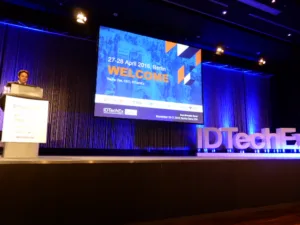Research firm IDTechEx holds printed electronics events twice a year: once in Berlin, and once in Santa Clara. We attended the European event at the end of April. In the past, IDTechEx held other events throughout the year focusing on topics such as wearables and energy harvesting; recently, the firm has combined all of them into a single showcase.
CEO Raghu Das told us that the shows were combined because of topic overlap – wearables and energy harvesting, for instance, or sensors and the IoT. It simply didn’t make sense to run them separately, and have people travel to Berlin twice in as many months for something that could be accomplished in a single trip. The event as a whole is known as the IDTechEx Show.
Das told us that around 2,500 people were attending, and about 3,500 are expected at the US show in November.
Das also gave the opening keynote of the event. 57 countries were represented, with 17% more pre-registrations and 27% more exhibitors than 2015.
There was a brief overview of the markets that IDTechEx covers – one of which is displays. The firm estimates this business to be worth around $120 billion, with huge investments coming in plastic and flexible displays. LG Display, for example, has announced an investment of $8.7 billion (LGD Confirms Plans for Large OLED Factory).
LCD is by far the largest display market, and makers are seeking to differentiate their products – for example, with quantum dots. The QDOT LCD business will be worth $500 million this year and $3 billion by 2020. However, displays are moving to new battlegrounds such as micro LED and QDOT emissive products.
On wearables, IDTechEx believes that electronic textiles (e-textiles) such as smart clothing will represent 45% of the wearable market by value in 2020. Value will grow from $119 million today to $878 million in 2020.
Graphene companies were much in evidence at the show, although Das only referred to them in terms of energy storage (a growing focus area, forecast to represent 38% of the graphene market by 2020). Carbon nanotubes were also present, but only for batteries – not as an ITO replacement.

